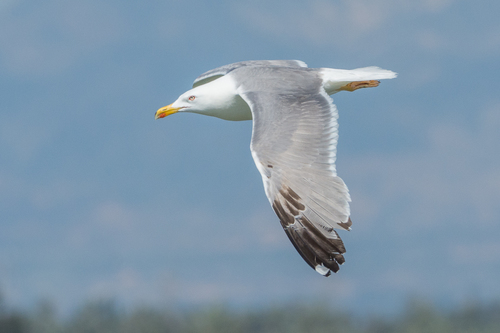
Yellow-legged Gull
The Yellow-legged Gull (*Larus michahellis*) is a large gull species found primarily in Europe, the Middle East, and North Africa. It was once considered a subspecies of the Herring Gull, but is now recognized as a distinct species. Yellow-legged Gulls are highly adaptable, thriving in a variety of habitats including coastal areas, wetlands, and even inland urban environments. They play a significant ecological role as both predators and scavengers, helping to regulate populations of smaller animals and contributing to nutrient cycling. While not typically considered culturally significant in the same way as some iconic bird species, their presence is a familiar sight in many coastal European cities.
52-68 cm
Length
120-155 cm
Wingspan
Least Concern
Conservation Status
Distribution
Primarily found around the Mediterranean Sea and the Black Sea. Its range extends along the Atlantic coasts of Europe, from Portugal north to France and, increasingly, the British Isles. Populations also exist in North Africa (Morocco, Algeria, Tunisia) and the Middle East. They are generally non-migratory, though some populations exhibit short-distance dispersal, particularly juveniles.
Lifespan
Up to 26 years recorded in the wild, but typically 10-15 years.
Yellow-legged Gull's Habitat
Habitat Types
Coastal cliffs, Rocky shores, Islands, Estuaries, Lagoons, Harbors, Landfills, Agricultural fields (inland)
Climate Zones
Mediterranean, Temperate
Adaptations
Yellow-legged Gulls are highly adaptable to various food sources and nesting sites. Their strong beaks and digestive systems allow them to consume a wide range of prey and scavenged materials. Their ability to tolerate human presence has allowed them to thrive in urban environments.
Variations
There is some debate about subspecies, with *L. m. atlantis* (found in the Azores, Madeira, and Canary Islands) sometimes considered a separate species (Atlantic Gull). Other recognized subspecies include *L. m. michahellis* (the nominate subspecies) and *L. m. lusitanius* (found in Portugal). These subspecies show slight variations in size and plumage.
Appearance
Breeding Plumage
Adult plumage is similar year-round. Breeding adults have a clean white head, dark grey back, and yellow legs and bill. Non-breeding adults may show some dark streaking on the head.
Seasonal Feather Changes
Limited seasonal variation, mainly restricted to head streaking in non-breeding plumage.
Sex Based Plumage Differences
Minimal sexual dimorphism in plumage; males and females are visually very similar.
Notable Features
Bright yellow legs (distinguishing them from Herring Gulls), Red spot on the lower mandible (gonys), Dark grey mantle (back), White head and underparts, Powerful, slightly hooked bill
Diet and Feeding
Primary Foods
Fish, Crustaceans, Mollusks, Insects, Carrion, Refuse (from landfills), Eggs and chicks of other birds
Foraging Behavior
Opportunistic feeders, employing a variety of techniques. They forage by walking, swimming, or flying. They may drop hard-shelled prey onto rocks to break them open. They also scavenge extensively, particularly at landfills and fishing ports.
Specializations
Their strong bill allows them to handle a wide variety of prey items, including those with hard shells. They are adept at kleptoparasitism, stealing food from other birds.
Seasonal Diet Variations
Diet can vary seasonally depending on prey availability. During the breeding season, they may focus more on fish and marine invertebrates. In winter, they may rely more on scavenging and inland food sources.
Behavior
Social Structure
Often found in flocks, especially outside the breeding season. They breed in colonies, which can range from a few pairs to thousands of birds.
Communication
Loud, raucous calls, including a 'long call' used for territorial defense and mate attraction, Head-tossing and other visual displays, Alarm calls to warn of predators
Migration
Mostly resident or dispersive, with some short-distance movements. Juveniles tend to disperse more widely than adults.
Territorial or Group Behaviors
Highly territorial during the breeding season, defending their nest site and surrounding area from other gulls and predators. Outside the breeding season, they often form large feeding and roosting flocks.
Conservation
Threats
Habitat loss (coastal development), Pollution (oil spills, plastic ingestion), Disturbance at breeding colonies, Climate change (affecting prey availability), Persecution (historically, due to perceived competition with fisheries)
Protection Programs
Protected under various international agreements, including the Agreement on the Conservation of African-Eurasian Migratory Waterbirds (AEWA), Monitoring of breeding colonies, Habitat restoration projects in some areas
Local National Laws
Protected under national wildlife legislation in many European countries.
Population Trend
Generally increasing, particularly in Western Europe.
Population Estimates
Global population estimated to be in the hundreds of thousands of pairs; difficult to assess precisely due to wide range and ongoing expansion.
Interesting Facts
They are known for their adaptability and have successfully colonized urban environments.
This has led to increased interactions with humans, sometimes resulting in conflict.
Yellow-legged Gulls are opportunistic predators and scavengers.
This allows them to thrive in a variety of habitats and exploit diverse food sources.
They can live for over 20 years.
This relatively long lifespan contributes to their population stability.
Faqs about Yellow-legged Gull
What is the difference between a Yellow-legged Gull and a Herring Gull?
Yellow-legged Gulls have yellow legs, while Herring Gulls have pink legs. Yellow-legged Gulls also tend to have a darker grey back and a more pronounced red spot on the bill.
Are Yellow-legged Gulls aggressive?
They can be aggressive, particularly during the breeding season when defending their nests and chicks. They may also be bold in scavenging for food, sometimes approaching humans closely.
Do Yellow-legged Gulls migrate?
Most populations are resident or show short-distance dispersal. Juveniles tend to wander more widely than adults, but they are not considered truly migratory.
What should I do if I find an injured Yellow-legged Gull?
Contact a local wildlife rehabilitation center or animal rescue organization. Do not attempt to handle the bird yourself, as they can inflict a painful bite.
Copyright @ Nature Style Limited. All Rights Reserved.
 English
English